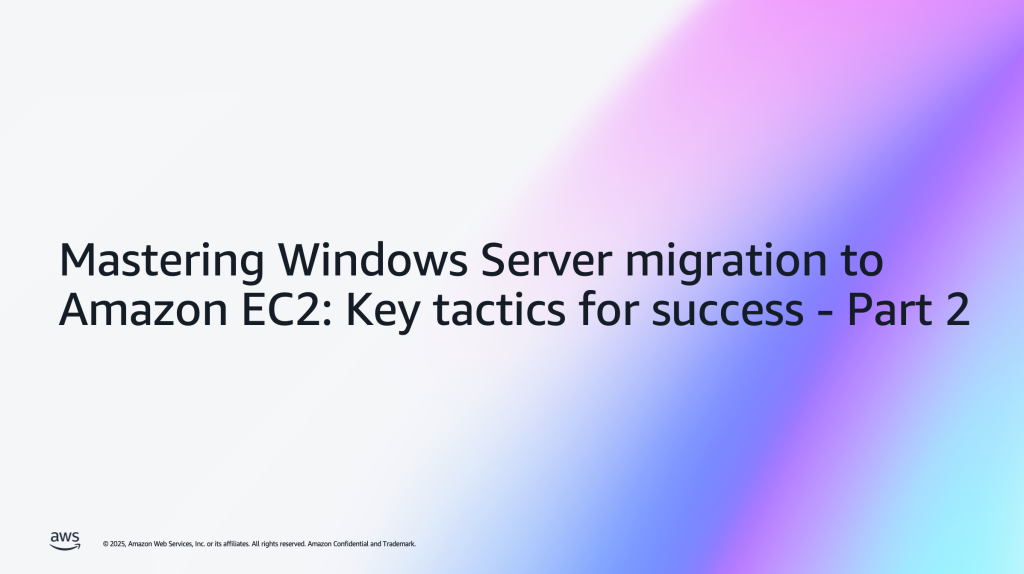Microsoft Workloads on AWS
Category: Migration & Transfer Services
Mastering Windows Server migration to Amazon EC2: Key tactics for success – Part 2
Introduction This two-part series equips you with essential knowledge for a successful Windows Server migration to Amazon Elastic Compute Cloud (Amazon EC2). Part 1 laid the groundwork by exploring critical licensing decisions and Active Directory integration strategies. Building on that foundation, this post delves into the technical intricacies of preparing your Windows Server instances for […]
Operating BYOL Windows Server Workloads Effectively on AWS
One way that customers running Microsoft Workloads on Amazon Web Services (AWS) may reduce costs is taking advantage of Bring Your Own License (BYOL) for eligible licenses they own. In this blog post, we are going to share a few practices to help you optimize your operation of BYOL Windows Server workloads on AWS. Introduction […]
Containerize your legacy ASP.NET application in a few clicks using AWS Migration Hub Orchestrator
In this blog post, we will cover how to containerize and deploy an ASP.NET application running on an Amazon Elastic Compute Cloud (Amazon EC2) for Microsoft Windows Server instance to Amazon ECS on AWS Fargate using AWS Migration Hub Orchestrator.
How to bring existing Windows Server and SQL Server licenses to Amazon EC2
Disclaimer: The use of Microsoft software is subject to Microsoft’s terms. When using Microsoft Software as a customer of AWS, you are fully responsible for complying with Microsoft licensing terms. This information is only provided as a guide for your convenience, and you should not rely on its descriptions nor consider it any form of […]
Modernizing .NET Applications to Microservices using AWS Migration Hub Refactor Spaces
In this blog, we’ll dive into how to effectively use AWS Migration Hub Refactor Spaces for modernizing legacy .NET Framework monolithic applications to a microservices based architecture. Refactoring can bring many benefits, but may come with challenges such as compatibility issues, addressing existing technical debt, and integration with modern systems. However, with the right approach, it’s possible to […]
Convert licenses of SQL Servers migrated with AWS Application Migration Service
In this blog post, I will show you how to convert Microsoft SQL Server licenses to an AWS provided license included using post-launch settings in the AWS Application Migration Service (AWS MGN). When you are migrating your SQL Servers to Amazon Web Services (AWS), you have a variety of options for using new and existing […]
Optimizing large-scale migration of SQL Server databases to Amazon EC2 using backup metadata
In this blog post, we explore how the Microsoft SQL Server backup metadata, known as backup headers, can be leveraged when migrating from on premises to Amazon Elastic Compute Cloud (Amazon EC2). This technique is particularly useful when access to source database information is non-existent or only backup files are available with no access to […]
Migrate SQL Server databases to AWS with minimal downtime using AWS Migration Hub Orchestrator
In this blog post, we will show you how to configure AWS Migration Hub Orchestrator using the recently-launched support for transactional log backups to reduce downtime during Microsoft SQL Server database migrations to Amazon Web Services (AWS). Customers worldwide trust AWS to run their mission-critical SQL Server databases. For SQL Server databases that are still […]
How to migrate a large-scale SQL Server database over low bandwidth using AWS Application Migration Service
In this blog post, we will demonstrate how to migrate a Microsoft SQL Server database on a low bandwidth network using AWS Application Migration Service (AWS MGN), AWS Snowcone, and SQL Server Log Shipping technology. Customers use different migration strategies to lift-and-shift their on-premises SQL Server workloads to the AWS Cloud. One of those approaches […]
Year in review 2023: AWS for Microsoft workloads
Celebrating 15 years of running Microsoft workloads in the cloud, longer than any other major cloud provider Before we wrap up 2023, I wanted to capture some of the highlights of the year—so I reached out to my esteemed colleague, Rajesh Rathod. Rajesh is an Amazon Elastic Cloud Compute (Amazon EC2) product leader who has […]









